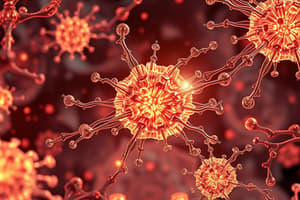Podcast
Questions and Answers
In a compound, why is the number of positive and negative charges equal?
In a compound, why is the number of positive and negative charges equal?
To ensure that the overall charge on the compound is zero.
What is a molecular ion?
What is a molecular ion?
A species made up of two or more atoms covalently bonded with an overall charge.
Can you give some examples of molecular ions?
Can you give some examples of molecular ions?
Sulfate (SO42-), sulfite (SO32-), thiosulfate (S2O32-), hydrogensulfate (HSO4-), hydrogencarbonate (HCO3-), carbonate (CO32-), nitrate (NO3-), nitrite (NO2-), phosphate (PO43-), chlorate (ClO3-), hypochlorite (ClO-), hydroxide (OH-), dichromate (Cr2O72-), chromate (CrO42-), manganate(VII) (MnO4-), ammonium (NH4+).
How are molecular ions represented in a chemical formula?
How are molecular ions represented in a chemical formula?
Can you provide an example of a compound with multiple molecular ions in its formula?
Can you provide an example of a compound with multiple molecular ions in its formula?
What is the overall charge on a compound with an equal number of positive and negative charges?
What is the overall charge on a compound with an equal number of positive and negative charges?
Define a molecular ion.
Define a molecular ion.
Provide examples of common molecular ions.
Provide examples of common molecular ions.
How are molecular ions represented in a chemical formula?
How are molecular ions represented in a chemical formula?
What is the molecular ion in calcium hydrogencarbonate?
What is the molecular ion in calcium hydrogencarbonate?
Flashcards are hidden until you start studying
Study Notes
Charge Balance in Compounds
- In a compound, the number of positive and negative charges is equal to maintain electrical neutrality.
- This balance allows compounds to form stable structures.
Molecular Ions
- A molecular ion is a charged entity comprised of two or more atoms bonded together.
- Molecular ions can carry a positive (cations) or negative (anions) charge.
Examples of Molecular Ions
- Common examples of molecular ions include:
- Ammonium (NH₄⁺)
- Nitrate (NO₃⁻)
- Sulfate (SO₄²⁻)
- Carbonate (CO₃²⁻)
Representation in Chemical Formulas
- Molecular ions are represented in chemical formulas with their respective charge indicated.
- For example, ammonium is denoted as NH₄⁺ and sulfate as SO₄²⁻.
Compounds with Multiple Molecular Ions
- Some compounds contain multiple different molecular ions in their formula, such as potassium sulfate (K₂SO₄), which includes the potassium ion (K⁺) and sulfate ion (SO₄²⁻).
Overall Charge of Neutral Compounds
- A compound that has an equal number of positive and negative charges has an overall neutral charge of zero.
Definition of Molecular Ion
- A molecular ion consists of a group of atoms that collectively possess a charge due to the loss or gain of electrons.
Common Molecular Ions
- Common molecular ions include:
- Hydroxide (OH⁻)
- Phosphate (PO₄³⁻)
- Acetate (C₂H₃O₂⁻)
Specific Example: Calcium Hydrogencarbonate
- In calcium hydrogencarbonate (Ca(HCO₃)₂), the molecular ion is the bicarbonate ion (HCO₃⁻).
Studying That Suits You
Use AI to generate personalized quizzes and flashcards to suit your learning preferences.



